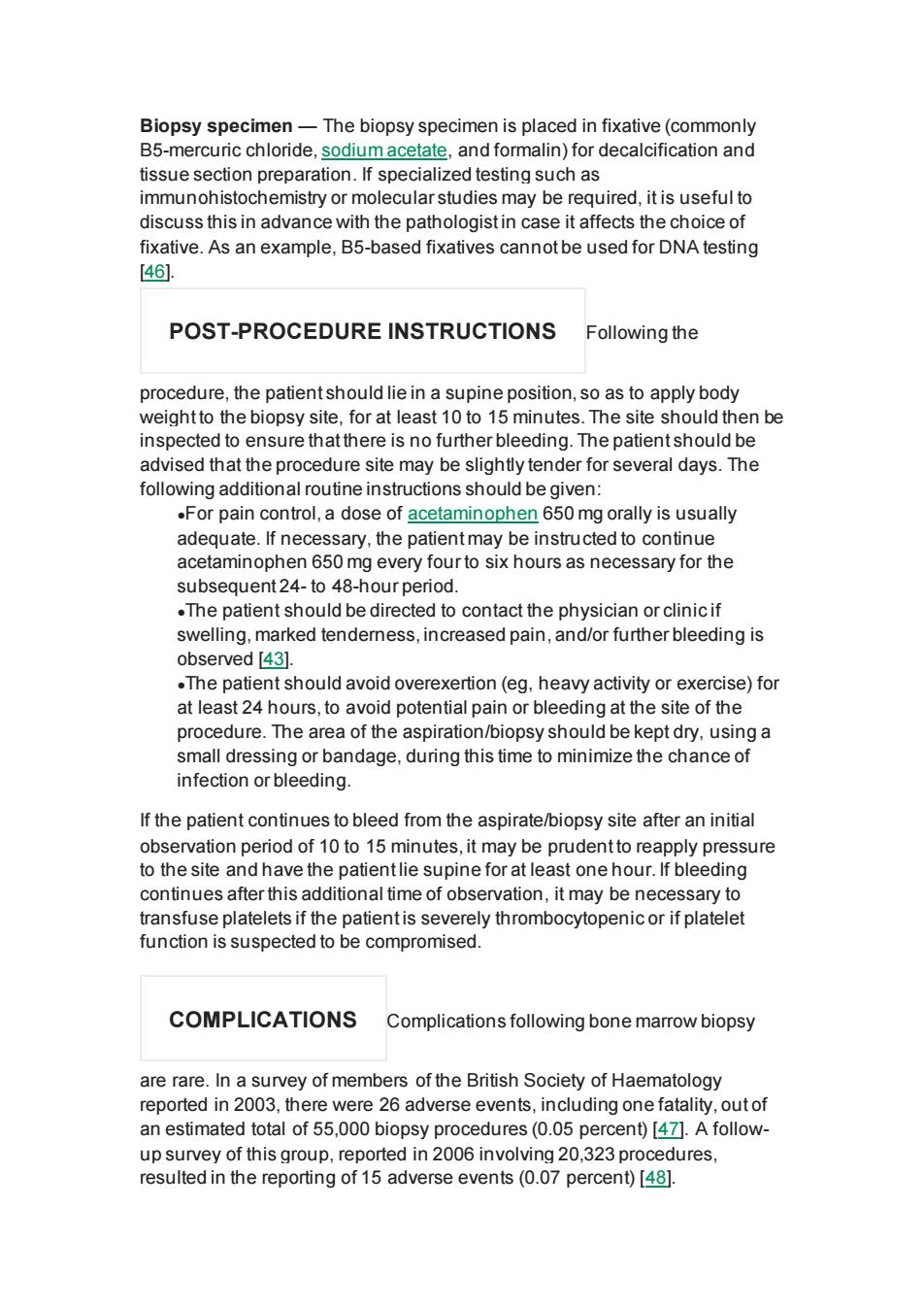正在加载图片...

Biopsy specimen-The biopsy specimen is placed in fixative(commonly B5-mercuric chloride,sodium acetate,and formalin)for decalcification and tissue section preparation.If specialized testing such as immunohistochemistry or molecular studies may be required,it is useful to discuss this in advance with the pathologist in case it affects the choice of fixative.As an example,B5-based fixatives cannot be used for DNA testing [46. POST-PROCEDURE INSTRUCTIONS Following the weightto the bi opsy site rat least10 015 The site en be inspected to ensure that there is no further bleeding.The patient should be advised that the procedure site may be slightly tender for several days.The following additional routine instructions should be given: .For pain control,a dose of acetaminophen 650 mg orally is usually adequate.Ifr sary,the patientmay be instru d to acetaminophen 650 mg every four to six hours as necessary for the subsequent24-to 48-hour period. .The patient should be directed to contact the physician or clinic if swelling,marked tenderess,increased pain,and/or further bleeding is observed [43]. .The patie nt should avoid overexertion(eg,heavy activity or exercise)for at least 24 hours.to avoid potential pain or bleeding at the site of the procedure.The area of the aspiration/biopsy should be kept dry,using a small dressing or bandage.during this time to minimize the chance of infection or bleeding. If the patient continues to bleed from the aspirate/biopsy site after an initial observation period of 10 to 15 minutes it may be prudentto reapply pressure continues after this additional time of observation,it may be necessary to transfuse platelets if the patientis severely thrombocytopenic or if platelet function is suspected to be compromised COMPLICATIONS Complications following bone marrow biopsy are rare.In a survey of members of the British Society of Haematology reported in 2003. there we re 26 adverse events,including one fatality,outof an estimated total of 55,000 biopsy procedures(0.05 percent)[47].A follow up survey of this group,reported in 2006 involving 20,323 procedures, resulted in the reporting of 15 adverse events(0.07 percent)[48].Biopsy specimen — The biopsy specimen is placed in fixative (commonly B5-mercuric chloride, sodium acetate, and formalin) for decalcification and tissue section preparation. If specialized testing such as immunohistochemistry or molecular studies may be required, it is useful to discuss this in advance with the pathologist in case it affects the choice of fixative. As an example, B5-based fixatives cannot be used for DNA testing [46]. POST-PROCEDURE INSTRUCTIONS Following the procedure, the patient should lie in a supine position, so as to apply body weight to the biopsy site, for at least 10 to 15 minutes. The site should then be inspected to ensure that there is no further bleeding. The patient should be advised that the procedure site may be slightly tender for several days. The following additional routine instructions should be given: ●For pain control, a dose of acetaminophen 650 mg orally is usually adequate. If necessary, the patient may be instructed to continue acetaminophen 650 mg every four to six hours as necessary for the subsequent 24- to 48-hour period. ●The patient should be directed to contact the physician or clinic if swelling, marked tenderness, increased pain, and/or further bleeding is observed [43]. ●The patient should avoid overexertion (eg, heavy activity or exercise) for at least 24 hours, to avoid potential pain or bleeding at the site of the procedure. The area of the aspiration/biopsy should be kept dry, using a small dressing or bandage, during this time to minimize the chance of infection or bleeding. If the patient continues to bleed from the aspirate/biopsy site after an initial observation period of 10 to 15 minutes, it may be prudent to reapply pressure to the site and have the patient lie supine for at least one hour. If bleeding continues after this additional time of observation, it may be necessary to transfuse platelets if the patient is severely thrombocytopenic or if platelet function is suspected to be compromised. COMPLICATIONS Complications following bone marrow biopsy are rare. In a survey of members of the British Society of Haematology reported in 2003, there were 26 adverse events, including one fatality, out of an estimated total of 55,000 biopsy procedures (0.05 percent) [47]. A followup survey of this group, reported in 2006 involving 20,323 procedures, resulted in the reporting of 15 adverse events (0.07 percent) [48]